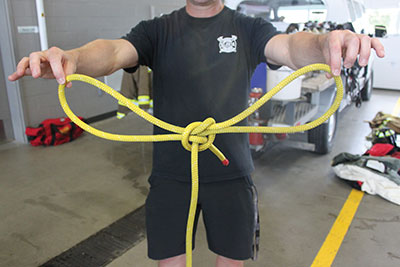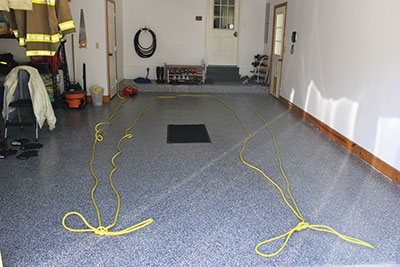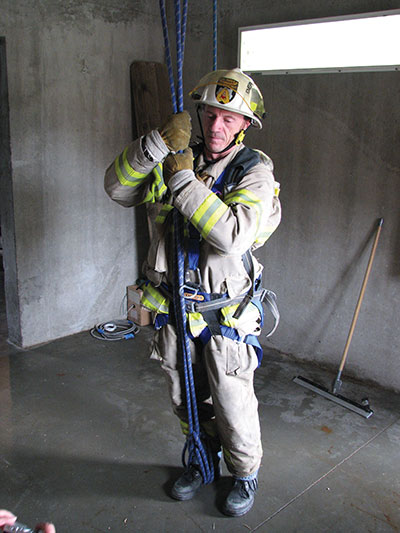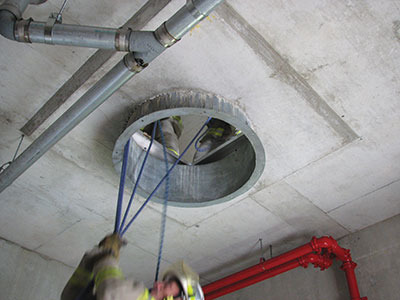
Back to Basics: October 2014
Mark Van
Features Structural TrainingWe are continuing to look at sub-level rescues with a focus on rescue tactics. In the July issue, we reviewed the use of a charged hoseline for rescuing a downed firefighter.
We are continuing to look at sub-level rescues with a focus on rescue tactics. In the July issue, we reviewed the use of a charged hoseline for rescuing a downed firefighter. Here, we examine rope as a rescue device.
Almost every fire apparatus carries a bag of life-safety rope. When setting up the RIT staging area, always include a bag of life-safety rope. Life-safety rope is stronger than utility rope and therefore is optimum for rescues, although, if utility rope is the only rope available, it will work. (However, nylon utility rope will not work in this type of rescue or situation; it will fail because of the extreme heat to which it will be exposed, the weight of the firefighter being rescued, and the tension being applied for the haul. Braid-on-braid utility rope is the preferred type of utility rope for this type of rescue.) Life-safety rope is eight millimetres (mm) in diameter or larger. The best diameter to work with is 12 mm or 1/2 inch as it is easier to handle while wearing structural firefighting gloves than eight mm or 10 mm rope; it is also the most common diaameter of rope used by fire departments on their apparatuses.
 |
|
| Photo 1: A basic handcuff knot is used when trying to rescue a firefighter from a sub-level. It is easy to set up and can be made with gloves on and in the dark. Photos by Mark Van Der Feyst
|
When rescuing a firefighter from a sub-level area, use a basic handcuff knot. This knot is easy to tie and can be made with gloves on and in the dark. Practise tying the knot in different situations such as zero visibility and while wearing gloves. The advantage of the handcuff knot is that it has large loops, which are easy for rescuing firefighters to handle while wearing gloves and provides access points for the downed firefighter. The handcuff knot is essentially a clove-hitch knot with a slight adjustment – the two loops are pulled through each other in a bow-like fashion (see photo 1). (Detailed instructions on how to tie a handcuff knot are available on YouTube: https://www.youtube.com/watch?v=HMtzGyd9cCc )
One bag of rescue rope will generally suffice for a sub-level rescue. Ideally, rescuers want to have 100 feet or 30 metres of rope. From the one bag of rope, rescuers can set up at least two pull lines with one set of loops or four pull lines with two sets of loops so that two firefighters or four firefighters can pull up on the rope.
 |
|
| Photo 2: Four pull lines are created with two sets of loops, each fashioned with a V on one side of the opening.
|
The trick to making two pull lines or four pull lines is setting up the rope in a V fashion alongside the hole or opening through which the downed firefighter has fallen. The lengths of the V shape form the two pull lines and allow a firefighter to tie a handcuff knot at the end/bottom of the V. If four pull lines are desired with two sets of loops, then two Vs are set up with each V on one side of the opening (see photo 2). In the photo, the black mat represents an opening in the floor. Notice how the lines are flaked out in relation to the opening with the loops already pre-tied for deployment.
The lengths of the V need to allow for extra rope to be lowered down into the hole, secure the downed firefighter, and then hoist him back up. The hoisting operation requires a good length of rope so that the rescuing firefighters can pull the rope hand over hand. Do not worry about having too much rope on one side or both sides; the extra rope will provide additional slack for the operation.
 |
|
| Photo 4: If the firefighter is conscious and can assist himself, he can take the lowered handcuff knot(s) and put them around one foot.
|
If the fallen firefighter is conscious and free of any entrapments or injuries, all that is required is to lower a set of ropes down to him or her with a handcuff knot pre-tied. The fallen firefighter then takes the handcuff knot(s) and puts them around one foot (see photo 4). The downed firefighter then crosses his other foot over the foot on which he has put the handcuff knot(s) to ensure that the knots will not come off. The firefighter then grabs the ropes with both hands and readies himself for hoisting. The firefighter needs to make sure that he has a firm grasp of all the ropes so that they will remain taut and in one place. If the ropes slacken and move, the operation will not work.
 |
|
| Photo 3: The rescue crew exerts a large amount of energy in a short amount of time hoisting the fallen firefighter.
|
By keeping his body stiff, the fallen firefighter can be hoisted up quite quickly (see photo 3). Once the fallen firefighter is at the top of the opening, he can be pulled out and away from the hole.
The rescuing firefighters work in unison in order to use the ropes effectively. The rescuers also maintain constant communication with the downed firefighter to address the psychological aspect of the rescue operation. Rescuing firefighters may need to shout step-by-step instructions to help a traumatized, downed firefighter and ensure the operation is a success. The fallen firefighter may be confused and may need some coaching to put on the handcuff knots, secure them to his body and then maintain a stiff body while being pulled up.
This technique works great when there is rope available for the rescue, and that means having the rope bag available at the RIT staging area. Simple rope work helps raise a fallen firefighter up and out of a hole or opening in a floor. Practising this technique will prove its worth.
Mark van der Feyst is a 15-year veteran of the fire service. He works for the City of Woodstock Fire Department in Ontario. Mark instructs in Canada, the United States and India and is a local-level suppression instructor for the Pennsylvania State Fire Academy and an instructor for the Justice Institute of BC. He is also the lead author of Pennwell’s Residential Fire Rescue book. Email Mark at Mark@Firestar-Services.com
Print this page